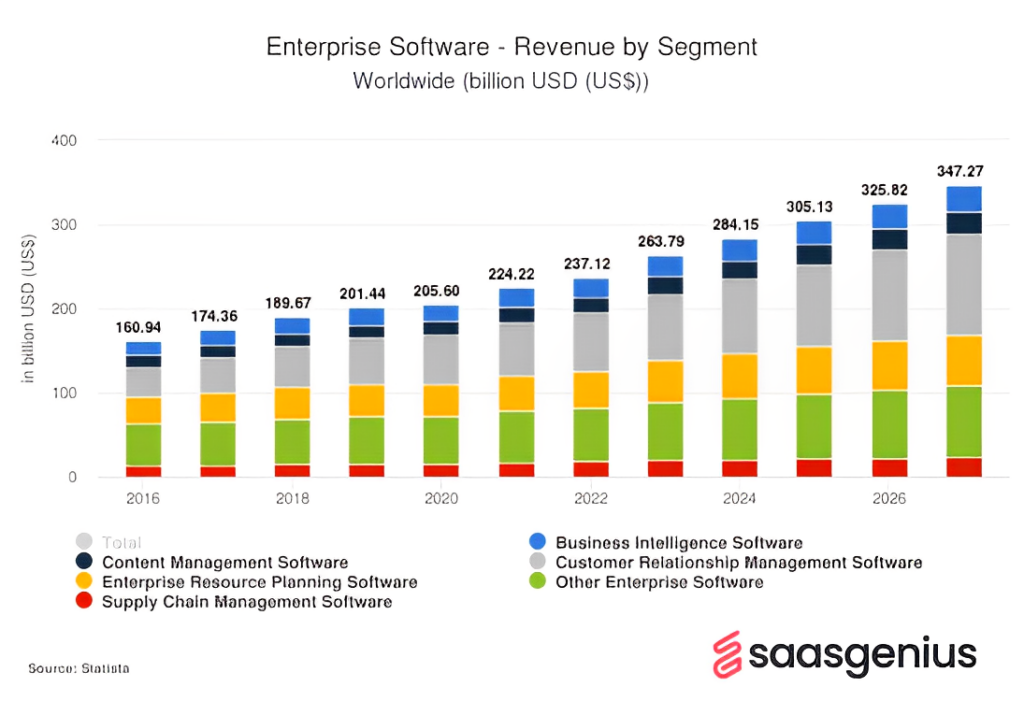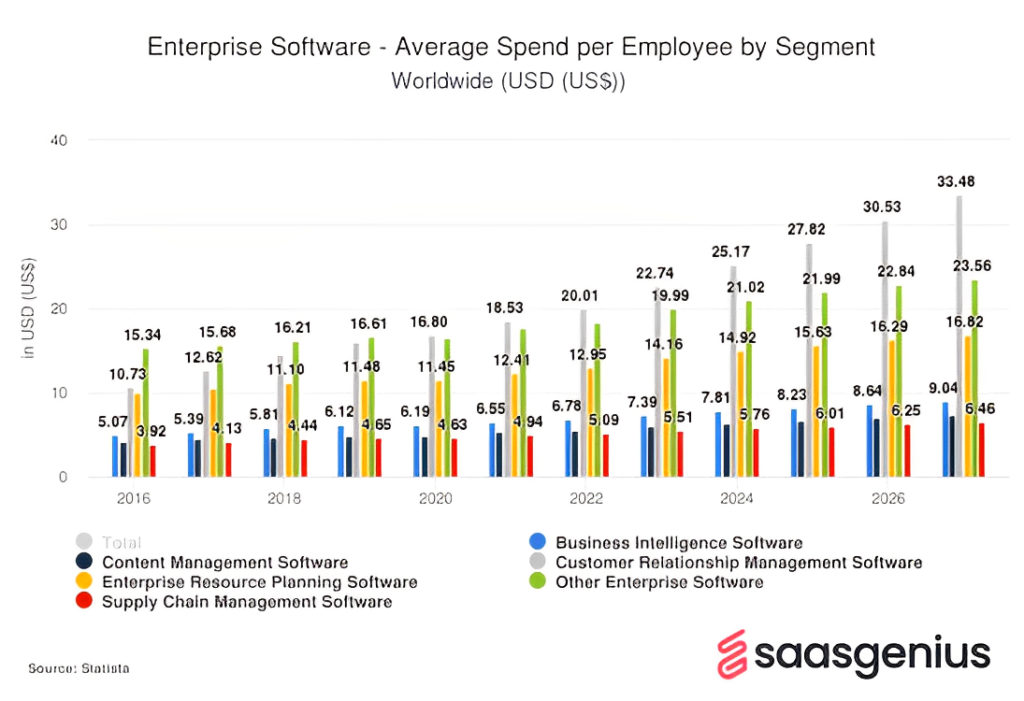Business SaaS Spend
The business enterprise software as a service (SaaS) industry has grown tremendously in recent years. Organizations of all sizes increasingly turn to cloud-based solutions to streamline their operations and increase efficiency.
As companies continue to adopt SaaS solutions at an ever-increasing rate, it is becoming more important than ever to understand and forecast the trends and spending patterns in this market.
This article provides a comprehensive analysis of the business enterprise SaaS spend and forecast from 2016 to 2027, including key drivers, challenges, and opportunities for growth in this dynamic and rapidly-evolving sector.

Business SaaS Spend and Revenue Statistics
In 2023, the estimation for the Enterprise Software sector will yield approximately US$263.80bn in revenue, with Customer Relationship Management Software making up the largest subsegment, expected to reach US$79.16bn in market volume. The industry predicts an annual growth rate of 7.12% from 2023 to 2027, leading to a market volume of US$347.30bn in 2027.

Furthermore, the graph above portrays the average expenditure per employee in the Enterprise Software sector, which will likely hit US$75.77 in 2023. Among all countries, the United States anticipates generating the most revenue, with a projected revenue of US$130.10bn in 2023.
What is Business Enterprise Software?
Enterprise software refers to software applications designed to meet large organizations or businesses’ unique needs and requirements. You can use these types of software to manage various business functions, such as accounting, customer relationship management (CRM), human resources, supply chain management, and project management.
Usually, enterprise software is scalable, flexible, and customizable to adapt to different organizations’ specific needs. It often includes features like data analytics, workflow automation, and collaboration tools, which can help organizations streamline their operations and improve their productivity.
How much do SaaS companies spend on marketing?
Although the yearly spend on marketing for SaaS companies varies, most marketing budgets are around 30% of the company’s total revenue. The amount a company spends on marketing usually depends on the size of the company. Larger businesses tend to spend around 40%, while smaller companies spend around 20% of their total revenue.
Searching the web for the best competitive intelligence software? Then make sure you don’t miss out on this post that will help you with the decision-making process! Get all the information about costs, features, trends, and more!
What are the key drivers, challenges, and opportunities for growth in the Enterprise Sector?
The enterprise software sector is a vast and rapidly growing industry that plays a critical role in driving innovation, efficiency, and productivity across various sectors of the economy. What are some key drivers, challenges, and opportunities for growth in the Enterprise Sector?
Key drivers
- The increasing demand for digitalization across all industries is a major driver for the growth of the enterprise software sector.
- The shift towards cloud-based solutions has become a significant trend in the industry and will continue to drive growth.
- Incorporating AI and machine learning into enterprise software has increased, providing new opportunities for growth and innovation.
- The rise of mobile devices has created a demand for mobile-friendly enterprise software solutions.
- The need for secure software solutions continues to grow as businesses look for reliable and safe options to protect their data.
Key challenges
- The enterprise software sector is highly competitive, with many players in the market, making it challenging for new entrants to establish themselves.
- Integrating new software solutions into existing systems can be complex and time-consuming, hindering adoption rates.
- Concerns around data privacy and security remain a significant challenge for the enterprise software sector.
- The cost of enterprise software solutions can be a significant barrier to adoption, especially for small and medium-sized businesses.
Key opportunities
- The continued development of emerging technologies such as blockchain and the Internet of Things (IoT) presents new opportunities for growth and innovation in the enterprise software sector.
- As businesses expand globally, there is a growing demand for enterprise software solutions that can accommodate diverse languages, currencies, and regulations.
- Developing industry-specific software solutions can provide new opportunities for growth in niche markets.
- The adoption of subscription-based software models provides an opportunity for vendors to generate recurring revenue and establish long-term relationships with customers.
Summary
Business SaaS spend is rising steadily year by year, and the forecast is that it will not slow down any time soon. More and more companies are adapting solutions, and thanks to the growth of this segment, the market size is expanding. In the age of digitalization, businesses need to understand that adapting these types of solutions is crucial to make their companies successful.
Frequently Asked Questions (FAQ)
Author
Methodology
- Who?
We are SaaS experts: Our specialists constantly seek the most relevant information to help support your SaaS business. - Why?
We are passionate about users accessing fair SaaS pricing: We offer up-to-date pricing data, reviews, new tools, blogs and research to help you make informed SaaS pricing decisions. - How?
With accurate information: Our website manager tests each software to add a Genius Score using our rating methodology to each product. Our editorial team fact-check every piece of content we publish, and we use first-hand testing, value metrics and leading market data.